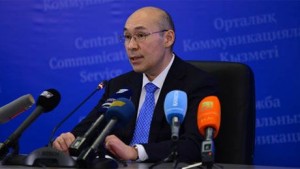 The National Bank of Kazakhstan’s recent decision to devalue the tenge by 19 percent was an unwelcome surprise for institutional investors and the local market.
The National Bank of Kazakhstan’s recent decision to devalue the tenge by 19 percent was an unwelcome surprise for institutional investors and the local market.
“Most investors were caught off guard. These kinds of moves by the central bank, made without a warning, naturally add a greater element of risk and frustration when it comes to investing in the country,” said Simon Mandel, vice-president on the Emerging Europe Equities desk at Auerbach Grayson in New York.
This is not the tenge’s largest scale devaluation in its 20-year history. In February 2009, the Almaty-based National Bank devalued the currency by 21 percent in an attempt to support the Kazakh economy in the aftermath of the global financial crisis. However, despite the magnitude and unexpected nature of the most recent devaluation, Mandel added that the devaluation has not resulted in a mass exit of large investors.
“We have seen a good deal of movement in Kazakh equities (after the central bank’s announcement), mostly out. That said, there has not been a mass exodus of any sort. First off, the liquidity is still pretty tight in these names (especially Halyk and KCell), so it’s not like selling out of positions is easy to begin with. It appears that investors have accepted the new reality of the devalued currency, as well as a heightened risk atmosphere.”
Ian Hague, a portfolio manager at the Firebird Fund in New York, is one such investor and has a $330 million exposure to Kazakh equities. “We have been investing in Kazakhstan’s oil, metal and banking sectors since 1996. Our current Kazakh portfolio reflects our long-term investment strategy in the country and we have not made any changes to it in the aftermath of the devaluation,” said Hague.
According to the country’s central bank, the move to a new support level of 185 tenge per dollar, with a range of three tenge on either side, is intended to boost Kazakhstan’s competitive position economically and reduce speculative pressure on the currency. Prior to the most recent devaluation, the central bank gave no hint that devaluation was on the table, much less a devaluation of that magnitude. Nonetheless, the economic indicators were all there.
The tenge is the latest casualty on a long list of emerging market currencies that have declined relative to the US dollar over the past few months. Some of them, for example the Turkish lira, Brazilian real and South African rand, took a serious beating, losing as much as a quarter of their value vis-à-vis the dollar. A Bloomberg index of 20 emerging market exchange rates has weakened by 10 percent over the past 12 months, and this month dropped to the lowest level since 2009. Winding down of the quantitative easing programme in the U.S., coupled with weak global demand for commodities, resulted in an outflow of capital from developing markets into developed markets and put downward pressure on emerging market currencies across the globe. Only the Chinese renminbi and the South Korean won have proved immune to this trend.
For U.S. dollar-based investors, international currency exposure is always a serious consideration. Assuming that dividends remain flat in local currency terms, investors will see payouts decline in U.S. dollar terms to reflect the broad emerging market currency weakness. Consequently, investors have been fleeing to mature markets that offer more attractive yields and stable currencies.
Russia, another largely resource-based emerging economy and Kazakhstan’s major trading partner, also experienced significant capital outflow in 2013 and saw the ruble gradually decline in value against the dollar. The ruble, which Kazakhstan holds as a reserve currency along with dollars and euros, has depreciated by more than 16 percent against the dollar since January 2013, including a significant 5 percent drop in the first two months of 2014. After a slight recovery earlier, the ruble reached its all-time low against the dollar of 36.37 on March 3, according to data from the Central Bank of Russia (CBR), as the ruble became affected by ongoing uncertainty over Russia’s involvement in the crisis in Ukraine.
The ruble has fluctuated the most among of all emerging market (EM) currencies and is expected to decline further as the CBR is preparing to float the currency by 2015. The ruble’s decline has put additional pressure on the tenge, according to a Feb. 11 statement from the Kazakh National Bank.
Russia accounts for 17.7 percent of Kazakhstan’s total trade and over a third of Kazakhstan’s imports come from Russia. According to the Russian Federal Customs Service, Russia-Kazakhstan trade was $22.4 billion in 2012 and $13.1 billion in the first half of 2013. In mid-February, First Deputy Prime Minister Igor Shuvalov said the weaker tenge will have “no effect” on Russia because the two countries don’t have a currency union.
According to Tim Ash, chief emerging markets economist at Standard Bank Group Plc. in London, the National Bank of Kazakhstan’s decision to depreciate the tenge “reflects a combination of factors, including the steady deterioration in the current account position, worries over the impact of weak growth in Russia and the ruble’s managed depreciation.”
“Apparently, from the point of view of minimizing negative impacts on Kazakh society, a one-time surprise devaluation is much better than a series of smaller, incremental devaluations,” adds Alexei Deviatov, chief economist at Uralsib Bank in Moscow. “I also don’t think that the expectation of a further ruble decline is the primary reason for such a sizeable drop in the value of the tenge. More likely they (National Bank of Kazakhstan) wanted to boost their currency reserves and budget revenue. And they decided that a 19 percent devaluation would be an appropriate level to achieve that.”
“The scale of the move is clearly higher than we expected,” said a Moscow-based Bank of America economist Vladimir Osakovskiy in a note to clients. “We see limited devaluation pressures at the new level.”
Visor Capital, an Almaty-based investment bank, estimates that the 19 percent KZT depreciation will allow the national bank to increase its 2014 foreign currency reserves to $25 billion from the current levels of $20 billion. The regulator had been supporting the currency at 150-155 tenge to the dollar at a cost of $4.5 billion. According to the bank’s macroeconomic report, the devaluation is likely to worsen the trade balance in the near-term as “the volumes of exports and imports are relatively fixed in the short-run.” They expect positive effects from the devaluation to take effect in 2015 with declining imports and increasing non-commodity exports.
Kairat Kelimbetov, named the Kazakh Central Bank chairman in October 2013, is planning to target inflation within a range of 3-4 percent in the medium term.
Visor Capital analysts are less optimistic in their 2014 inflation forecast, and increased it by almost a full percentage point to 7.1 percent from the projected earlier 6.2 percent in anticipation of significant cost-push inflation as dollar denominated fixed production costs will increase. Local companies buy equipment and borrow in foreign currencies. The country’s foreign debt stands at roughly 67 percent of gross domestic product (GDP), with most of it (88 percent) foreign currency denominated. Servicing this debt in the aftermath of the devaluation will impose an additional burden on the government and corporate coffers.
Kazakhmys PLC, the country’s largest copper producer and one of the beneficiaries of the devaluation, announced plans to increase salaries by 10 percent. This move, as well as similar moves by other large companies in the country, though popular, could also risk spurring inflation..
Weakness in emerging markets is increasing, with analysts warning that more devaluations across the region could follow. Weaker currencies will improve the competitiveness of exports from emerging markets, but with China slowing and developed markets in a prolonged low-growth mode, anemic global demand will remain a challenge for exporters.
Still, macroeconomists agree that Kazakhstan is better-positioned than its peers to withstand the pressure on emerging markets. The country’s $204 billion economy, almost the size of Ireland’s, added 5.7 percent in the third quarter of 2013 and is forecasted for solid growth. Visor Capital upgraded its 2014 real GDP growth forecast to 6 percent from the previous estimate of 5 percent. In addition to healthy economic growth, Kazakhstan has an extra $70 billion available in a sovereign wealth fund that it does not count as part of its reserves.
“The economic logic of what is happening is inescapable. It’s proof of how far Kazakhstan still has to go to build a diversified economy, less susceptible to fluctuations in the global demand for commodities,” concluded Firebird’s Hague.


